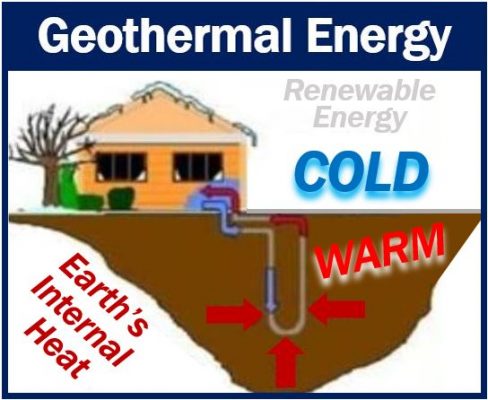Geothermal energy involves using heat from under the ground, i.e., the Earth’s internal heat. Much of what is below the ground is warm or hot. There is hot water, steam, hot rock, and further down magma. Magma is molten rock. Geothermal energy refers to capturing that energy and converting it into electricity or regulating the temperature of buildings.
Put simply; geothermal energy is power that we derive from the Earth’s internal heat.
In some parts of the world, people have been using geothermal energy for thousands of years. Traditionally, we have used it for heating. We have also used it for cooking.
The US Energy Information Administration says the following regarding the term:
“The word geothermal comes from the Greek words geo (earth) and therme (heat). Geothermal energy is heat within the earth. People can use this heat as steam or as hot water to heat buildings or to generate electricity.”

Geothermal energy – Earth’s internal heat
When radioactive particles in the Earth’s core decay, the process produces geothermal energy. The process also makes the core extremely hot. Did you know that our planet’s core is even hotter than the surface of the Sun?
The Earth has several layers:
The inner core and outer core
The inner core consists of solid iron. An outer core of hot molten rock surrounds the inner core. We call this hot molten rock magma.
The mantle
The mantle, which is approximately 1,800 miles (2,896 km) thick, surrounds the outer core. It consists of rock and magma.
The crust
This is the Earth’s outermost layer. Our continents are on the Earth’s crust. The ocean floors are also on the Earth’s crust.
The crust is from 15 to 35 miles thick on the continents and about 3 to 5 miles thick under the sea.
Magma is the source of geothermal energy
The crust consists of tectonic plates. Tectonic plates are like giant jig-saw pieces. Magma seeps through where the tectonic plates meet. The magma comes close to the surface of the Earth. When the magma bursts through onto the surface, we have a volcanic eruption.
The lava that comes out of volcanoes is partly magma. Deep underground, water and rocks absorb heat from the magma. The hottest rocks and water are located deeper underground.
Geothermal energy – heat and electricity
We use geothermal energy to produce electricity and heat our homes by drilling deep wells. We then pump the steam or hot water to the surface.
The top three meters (c. ten feet) of the Earth’s crust maintains an almost constant temperature of between 10° and 16°C (50° and 60°F). People use geothermal pumps to tap into this resource to raise the temperature of buildings. We can also use this resource, for example, in summer, to cool buildings.
According to Renewable Energy World, this is how we use geothermal pumps:
“A geothermal heat pump system consists of a heat pump, an air delivery system (ductwork), and a heat exchanger-a system of pipes buried in the shallow ground near the building.”
“In the winter, the heat pump removes heat from the heat exchanger and pumps it into the indoor air delivery system. In the summer, the process is reversed, and the heat pump moves heat from the indoor air into the heat exchanger.”
“The heat removed from the indoor air during the summer can also be used to provide a free source of hot water.”
Geothermal energy – renewable energy
Geothermal energy is renewable energy. In this context, ‘renewable‘ means that it never runs out., In other words, we can never use it all up so that there is none left. The source of that energy is always available. Always available, that is, in a human timescale.
Solar energy, wind energy, and hydropower, for example, are forms of renewable energy. Biomass is also renewable energy.
Solar energy captures the Sun’s energy and converts it into electricity. In a human timescale, the Sun and its energy are always available.
Wind energy captures the energy from moving air – wind – and also converts that energy into electricity. Wind is always available.
Hydroenergy or hydropower captures the energy from falling or moving water. We will never run out of moving or falling water. Tidal energy, for example, is a type of hydropower.
Earth – a huge source of energy
Regarding using the Earth’s internal heat as a source of energy, the British Geological Survey says:
“Our planet is a huge source of energy. In fact, 99.9 percent of the planet is at a temperature greater than 100°C; so geothermal energy is a significant renewable resource.”
“In Iceland, which has abundant geothermal energy resources, geothermal energy is used to provide the majority of the electricity and heating demands of the country.”
